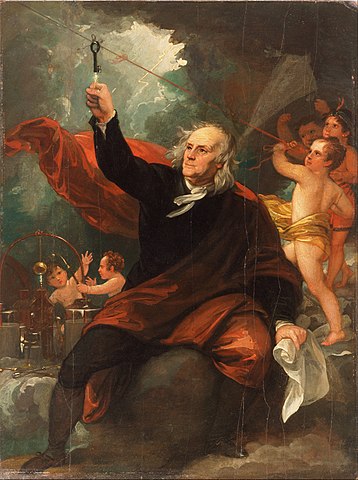Franklin Invents The Motor

Benjamin Franklin is remembered for many reasons today—as inventor, statesman, commentator, and patriot—but he is perhaps best known as an electrical experimenter and theorist. He named the two states of electricity, positive and negative; he showed that lightning was electric with his famous kiteflying experiment; and he explained the action of the Leyden jar, the earliest capacitor.
The Leyden jar was invented in 1745 by Ewald Georg von Kleist of Germany and independently a year later by Pieter van Musschenbroek of the University of Leyden. A typical one consisted of a glass jar half full of water with a wire sticking through a cork at the top. The experimenter would produce static electricity by, for example, rubbing a piece of fur or turning the handle of a generating device, and use the wire to store it inside the jar. Touching the exposed end of the wire again would deliver a jolt of electricity.
Soon after their discovery Leyden jars became widely popular among European intellectuals. Franklin started his electrical investigations in 1747 after receiving an “electric tube” from his friend and business associate Peter Collinson of London. Within a few months he was completely engrossed. He sent long accounts of his findings to Collinson and others. Among his experiments in 1748 he assembled an “electrical Wheel, that turns with considerable Strength.”
Franklin described his apparatus as follows: “A small upright Shaft of Wood passes at right Angles thro’ a thin round Board of about a Foot Diameter, and turns on a sharp Point of Iron, fixt in the lower End, while a strong Wire in the upper End, passing thro’ a small Hole in a thin Brass Plate, keeps the Shaft truly vertical. About 30 Radii of equal Length made of Sash Glass, cut in narrow Strips, issue Horizontally from the Circumference of the Board; the Ends most distant from the Center being about 4 Inches apart. On the End of every one, a Brass Thimble is fixt.”
Electrostatic motors remained a backwater until recently, but now they have returned, in the form of tiny devices invisible to the naked eye.
Wires from two Leyden jars—one charged positively, the other negatively—were placed near the circumference of the wheel, which was then set in motion with a small push. As each thimble passed the positive jar, it absorbed a charge of positive electricity, repelling it from that jar and attracting it toward the negative one. This exerted a torque on the wheel. Upon reaching the negative jar, the thimble would absorb another charge, large enough to give it a net negative charge. This repelled it from the negative jar and attracted it to the positive one. The wheel kept turning in this fashion until the charges in the jars were depleted.
According to Franklin, the wheel rotated “with great Rapidity, 12 or 15 rounds in a Minute, and with such Strength, as that the Weight of 100 Spanish Dollars, with which we once loaded it, did not seem in the least to retard it’s motion.” Franklin called his motor an “electrical jack” and believed that it could do work in the world: “If a large Fowl were spitted on the upright Shaft, it would be carried round before a Fire with a Motion fit for Roasting.”
By the end of the eighteenth century electrostatic motors had been installed in place of spring drives in a few devices. One was used in an orrery (a machine that displays the movements of the earth, sun, moon, and planets); others found their way into toys. Still, the hassle of charging Leyden jars made the devices little more than novelties.
Interest in Franklin’s “electrical jack” waned after Alessandro Volta announced his discovery of the wet cell in 1800. Voltaic cells provided a steady direct current instead of sparks, opening up the new field of electrodynamics. They soon gave rise to the first electromagnetic motors. Electrostatic motors remained a backwater until recently, but now they have returned, in the form of tiny devices invisible to the naked eye. They are built with techniques devised for microchip manufacture, but the principle behind them is the same one Franklin used nearly two and a half centuries ago.






